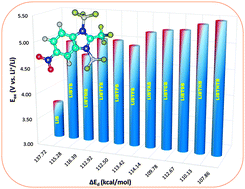Novel benzimidazole salts for lithium ion battery electrolytes: effects of substituents†
Abstract
In this paper, we report on our effort to design a novel lithium salt derived from bis(trifluoroborane)benzimidazolide by using density functional theory (DFT) calculations. The effects of different substituents are investigated with respect to ion pair dissociation energies and intrinsic anion oxidation potential of the molecules. Based on our calculations, we have found that ion pair dissociation energies and intrinsic anion oxidation potentials of the anions are mainly affected by the position and the type of substituents introduced into the parent structure. Compared to –CH3, substitution at the C2 position of the parent bis(trifluoroborane)benzimidazole (BTB−) by –CF3 results in an increase in anion oxidation stability. However, we observed a negligible change in the intrinsic anion oxidation potential as the length of the fluoroalkyl group increased to –C2F5. The most promising anions are generated by considering double-substitution at C2 and C5 positions. Among the possible anions, bis(trifluoroborane)-5-nitro-2-(trifluoromethyl) benzimidazolide (BTNTB−), with the calculated intrinsic anion oxidation potential of 5.50 V vs. Li+/Li, can be considered as a potential candidate for high voltage Li-ion batteries.


 Please wait while we load your content...
Please wait while we load your content...